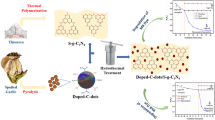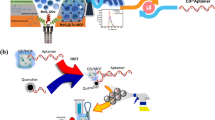Abstract
A dual-channel probe was developed, based on a novel composite metal organic frameworks (ZnMOF-74@Al-MOF) for glyphosate determination through ratio fluorescence and colorimetric methods. The prepared probe can not only recognize and combine glyphosate by introducing copper ion into the MOF, but also possess peroxidase-like catalytic activity. The recognition of target glyphosate brought about changes relative to its concentration on fluorescence intensity and ultraviolet absorption. And, the high specific surface area and porosity of porphyrin MOF provides the developed probe with more response opportunities to afford a better detection performance for glyphosate. Under optimum conditions, the copper ion-mediated method exhibited good detection performance for glyphosate with low detection limits (0.070 and 0.092 μg mL−1 for fluorescence and colorimetric techniques, respectively). Furthermore, the possible mechanisms of the fluorescence quenching and the peroxidase-like catalytic of the probe were also explored. This dual-channel method was applied to monitor glyphosate degradation in environmental samples and satisfactory results were obtained.
Graphical abstract






Similar content being viewed by others

References
Castle LA, Siehl DL, Gorton R, Patten PA, Chen YH, Bertain S, Cho H-J, Duck N, Wong J, Liu D, Lassner MW (2004) Discovery and directed evolution of a glyphosate tolerance gene. Science 304:1151–1154
Woodburn AT (2000) Glyphosate: production, pricing and use worldwide. Pest Manag Sci 56:309–312
Valle AL, Mello FCC, Alves-Balvedi RP, Rodrigues LP, Goulart LR (2019) Glyphosate detection: methods, needs and challenges. Environ Chem Lett 17:291–317
Xu J, Smith S, Smith G, Wang W, Li Y (2019) Glyphosate contamination in grains and foods: an overview. Food Control 106:106710
Clair É, Mesnage R, Travert C, Séralini G-É (2012) A glyphosate-based herbicide induces necrosis and apoptosis in mature rat testicular cells in vitro, and testosterone decrease at lower levels. Toxicol In vitro 26:269–279
Gui Y-X, Fan X-N, Wang H-M, Wang G, Chen S-D (2012) Glyphosate induced cell death through apoptotic and autophagic mechanisms. Neurotoxicol Teratol 34:344–349
Marc J, Mulner-Lorillon O, Bellé R (2004) Glyphosate-based pesticides affect cell cycle regulation. Biol Cell 96:245–249
Gasnier C, Dumont C, Benachour N, Clair E, Chagnon M-C, Séralini G-E (2009) Glyphosate-based herbicides are toxic and endocrine disruptors in human cell lines. Toxicology 262:184–191
Yuan Y, Jiang J, Liu S, Yang J, Zhang H, Yan J, Hu X (2017) Fluorescent carbon dots for glyphosate determination based on fluorescence resonance energy transfer and logic gate operation. Sensor Actuat B-Chem 242:545–553
Zhang Y, Dang Y, Lin X, An K, Li J, Zhang M (2020) Determination of glyphosate and glufosinate in corn using multi-walled carbon nanotubes followed by ultra high performance liquid chromatography coupled with tandem mass spectrometry. J Chromatogr A 1619:460939
Jiang R, Pang Y-H, Yang Q-Y, Wan C-Q, Shen X-F (2022) Copper porphyrin metal-organic framework modified carbon paper for electrochemical sensing of glyphosate. Sensor Actuat B-Chem 358:131492
Chiarello M, Jiménez-Medina ML, MarínSaéz J, Moura S, GarridoFrenich A, Romero-González R (2019) Fast analysis of glufosinate, glyphosate and its main metabolite, aminomethylphosphonic acid, in edible oils, by liquid chromatographycoupled with electrospray tandem mass spectrometry. Food Addit Contam: Part A 36:1376–1384
Stavra E, Petrou PS, Koukouvinos G, Economou A, Goustouridis D, Misiakos K, Raptis I, Kakabakos SE (2020) Fast, sensitive and selective determination of herbicide glyphosate in water samples with a White Light Reflectance Spectroscopy immunosensor. Talanta 214:120854
Fang H, Zhang X, Gao D, Xiao Y, Ma L, Yang H, Zhou Y (2022) Fluorescence determination of glyphosate based on a DNA-templated copper nanoparticle biosensor. Microchim Acta 189:158
Wu Z, Hu Y, Pan X, Tang Y, Dai Y, Wu Y (2022) A liquid colorimetric chemosensor for ultrasensitive detection of glyphosate residues in vegetables using a metal oxide with intrinsic peroxidase catalytic activity. Food Addit Contam: Part A 39:710–723
Chen H, Wang J, Shan D, Chen J, Zhang S, Lu X (2018) Dual-emitting fluorescent metal–organic framework nanocomposites as a broad-range pH sensor for fluorescence imaging. Anal Chem 90:7056–7063
Liu C-S, Li J, Pang H (2020) Metal-organic framework-based materials as an emerging platform for advanced electrochemical sensing. Coordin Chem Rev 410:213222
Daglar H, Gulbalkan HC, Avci G, Aksu GO, Altundal OF, Altintas C, Erucar I, Keskin S (2021) Effect of metal–organic framework (MOF) database selection on the assessment of gas storage and separation potentials of MOFs. Angew Chem Int Edit 60:7828–7837
Lin J, Ho W, Qin X, Leung C-F, Au VK-M, Lee S-C (2022) Metal–organic frameworks for NOx adsorption and their applications in separation, sensing, catalysis, and biology. Small 18:2105484
Wang S, Kai M, Duan Y, Zhou Z, Fang RH, Gao W, Zhang L (2022) Membrane cholesterol depletion enhances enzymatic activity of cell-membrane-coated metal-organic-framework nanoparticles. Angew Chem Int Edit 61:e202203115
Du L, He H, Xiao Z, Xiao H, An Y, Zhong H, Lin M, Meng X, Han S, Shuai X (2022) GSH-responsive metal–organic framework for intratumoral release of NO and IDO inhibitor to enhance antitumor immunotherapy. Small 18:2107732
Zhou Z, Mukherjee S, Hou S, Li W, Elsner M, Fischer RA (2021) Porphyrinic MOF film for multifaceted electrochemical sensing. Angew Chem Int Edit 60:20551–20557
Feng D, Gu Z-Y, Li J-R, Jiang H-L, Wei Z, Zhou H-C (2012) Zirconium-Metalloporphyrin PCN-222: mesoporous metal–organic frameworks with ultrahigh stability as biomimetic catalysts. Angew Chem Int Edit 51:10307–10310
Yang Y, Li L, Lin L, Wang X, Li J, Liu H, Liu X, Huo D, Hou C (2022) A dual-signal sensing strategy based on ratiometric fluorescence and colorimetry for determination of Cu2+ and glyphosate. Anal Bioanal Chem 414:2619–2628
Wang H, Rui J, Xiao W, Peng Y, Peng Z, Qiu P (2022) Enzyme-free ratiometric fluorescence and colorimetric dual read-out assay for glyphosate with ultrathin g-C3N4 nanosheets. Microchem J 180:107587
Ma Y, Su H, Kuang X, Li X, Zhang T, Tang B (2014) Heterogeneous nano metal–organic framework fluorescence probe for highly selective and sensitive detection of hydrogen sulfide in living cells. Anal Chem 86:11459–11463
Sheals J, Persson P, Hedman B (2001) IR and EXAFS spectroscopic studies of glyphosate protonation and copper(II) complexes of glyphosate in aqueous solution. Inorg Chem 40:4302–4309
Hou L, Song Y, Xiao Y, Wu R, Wang L (2019) ZnMOF-74 responsive fluorescence sensing platform for detection of Fe3+. Microchem J 150:104154
Yu H, Wu H, Tian X, Zhou Y, Ren C, Wang Z (2021) A nano-sized Cu-MOF with high peroxidase-like activity and its potential application in colorimetric detection of H2O2 and glucose. RSC Adv 11:26963–26973
Zheng H-Q, Liu C-Y, Zeng X-Y, Chen J, Lü J, Lin R-G, Cao R, Lin Z-J, Su J-W (2018) MOF-808: a metal–organic framework with intrinsic peroxidase-like catalytic activity at neutral pH for colorimetric biosensing. Inorg Chem 57:9096–9104
Chang Y, Zhang Z, Hao J, Yang W, Tang J (2016) A simple label free colorimetric method for glyphosate detection based on the inhibition of peroxidase-like activity of Cu(II). Sensor Actuat B-Chem 228:410–415
Wang C, Gao J, Cao Y, Tan H (2018) Colorimetric logic gate for alkaline phosphatase based on copper (II)-based metal-organic frameworks with peroxidase-like activity. Anal Chim Acta 1004:74–81
Wu H, Tong C (2019) Ratiometric fluorometric determination of silver(I) by using blue-emitting silicon- and nitrogen-doped carbon quantum dots and red-emitting N-acetyl-L-cysteine-capped CdTe quantum dots. Microchim Acta 186:723
Zhao J, Wang S, Lu S, Sun J, Yang X (2018) A luminescent europium-dipicolinic acid nanohybrid for the rapid and selective sensing of pyrophosphate and alkaline phosphatase activity. Nanoscale 10:7163–7170
Meftaul IM, Venkateswarlu K, Dharmarajan R, Annamalai P, Asaduzzaman M, Parven A, Megharaj M (2020) Controversies over human health and ecological impacts of glyphosate: is it to be banned in modern agriculture? Environ Pollut 263:114372
la Cecilia D, Maggi F (2018) Analysis of glyphosate degradation in a soil microcosm. Environ Pollut 233:201–207
Funding
This work was financially supported by the National Natural Science Foundation of China (22078369, 21904141 and 21878339) and the Key Research and Development Program of Hunan Province (2020SK2128).
Author information
Authors and Affiliations
Contributions
Yuni Yuan: investigation, method, writing—original draft; Wei Liu: supervision, investigation; Qi Liu: writing guide, investigation; Qing He: investigation; Yuyang Hu: investigation; Xinyu Jiang: project administration, supervision, writing—review and editing; Xiaoqing Chen: project administration, supervision.
Corresponding author
Ethics declarations
Conflict of interest
The authors declare no competing interests.
Additional information
Publisher's note
Springer Nature remains neutral with regard to jurisdictional claims in published maps and institutional affiliations.
Supplementary Information
Below is the link to the electronic supplementary material.
Rights and permissions
Springer Nature or its licensor holds exclusive rights to this article under a publishing agreement with the author(s) or other rightsholder(s); author self-archiving of the accepted manuscript version of this article is solely governed by the terms of such publishing agreement and applicable law.
About this article
Cite this article
Yuan, Y., liu, W., Liu, Q. et al. A dual-channel probe based on copper ion-mediated metal organic framework composite for colorimetric and ratiometric fluorescence monitoring of glyphosate degradation in soil and water. Microchim Acta 189, 372 (2022). https://doi.org/10.1007/s00604-022-05473-5
Received:
Accepted:
Published:
DOI: https://doi.org/10.1007/s00604-022-05473-5



